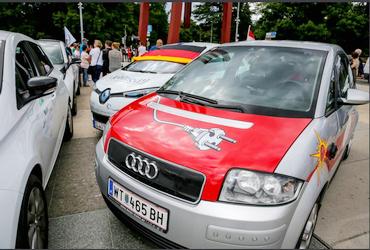
BRUSSELS, Belgium, August 31, 2016 (ENS) – The accelerating global shift towards low-carbon, circular economies has started, driving Europe’s need to accelerate the transition towards low-emission and zero-emission vehicles – a central pillar of the European Commission’s new mobility strategy.
Speeding up the deployment of advanced biofuels, electricity, hydrogen and renewable synthetic fuels and removing obstacles to the electrification of transport is another pillar forming the structure of the new strategy.
Increasing the efficiency of the entire transport system through digital technologies, smart pricing and further encouraging the shift to lower emission transport modes.

Announced in July in a Communication from the Commission to the European Parliament, the Council, the European Economic and Social Committee and the Committee of the Regions, the new strategy is intended to ensure Europe stays competitive and responsive to the increasing mobility needs of people and goods.
The low-emission mobility strategy “should be seen as one of the tools to modernise the European economy and strengthen its Internal Market,” the Commission said in a statement on July 20.
The Commission is looking into better synergies between the energy and transport systems to make charging of electric vehicles easier and more efficient.
In accordance with Directive on alternative fuel infrastructure , Member States are required to implement common standards, including a common plug for electric vehicles, and roll out infrastructure for alternative fuels.
In co-operation with Member States and the European Standardisation Organisations, the work on better interoperability and standardization for electro-mobility continues.
The Commission said it intends to develop a method for easy price comparison of electricity and other conventional and alternative fuels.
The Commission has already implemented some important improvements on how vehicle emissions are measured and verified. “This is a necessary precondition to ensure that standards have an impact and that consumers can trust them,” said the Commission in the wake of the VW defeat device scandal last year, during which the automaker was caught cheating on emissions tests in the United States.
Emissions from conventional combustion engines will need to be further reduced after 2020, so the Commission is working on post-2020 standards for cars and vans.
Together with this new strategy, the Commission is launching a public consultation to revise the current legislative framework for post-2020 emissions standards for cars and vans.
The Commission is working on improving customer information, reviewing the Car Labelling Directive and the incentives in public procurement rules, in the context of a revision of the Clean Vehicles Directive.
This can be a powerful tool to support deployment, for example, of zero-emission city buses.
The Commission will accelerate work to curb carbon dioxide emissions from lorries, or heavy haul freight trucks, buses and coaches. They currently represent around a quarter of road transport carbon dioxide emissions and their share is projected to grow.
While lorries, buses and coaches have been subject to similar air pollution standards as cars and vans, and are now required to meet them under real driving conditions, the EU has neither fuel efficiency standards for them, nor a system to monitor their carbon dioxide emissions.
Other parts of the world, such as the United States, China, Japan and Canada, have already introduced standards, and some European auto manufacturers participate in these schemes.
Together with this strategy, the Commission invites participation in a public consultation, which focuses on monitoring and reporting of emissions, but also seeks first feedback on standards.
Copyright Environment News Service (ENS) 2016. All rights reserved.
